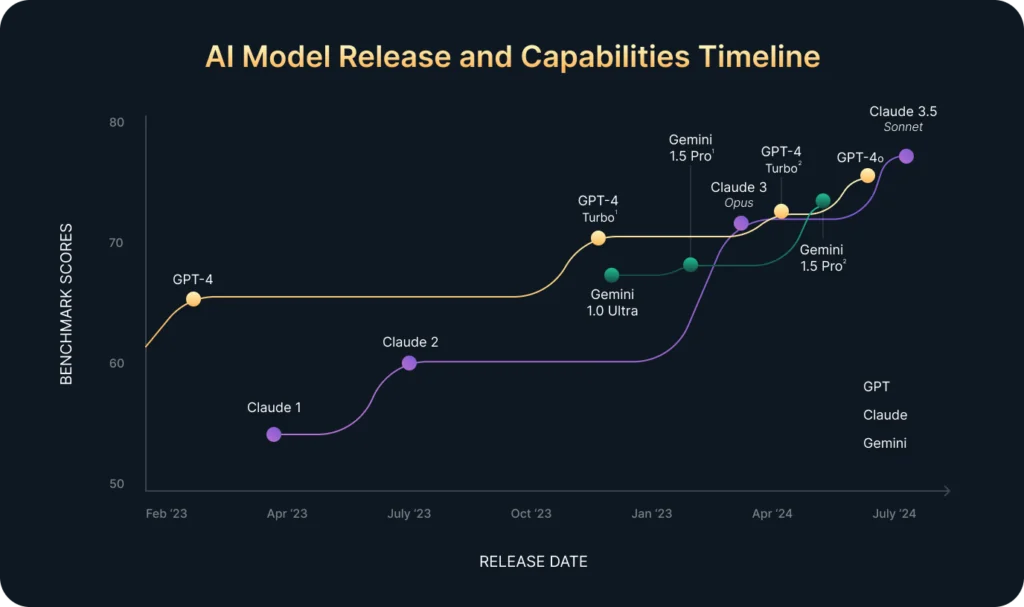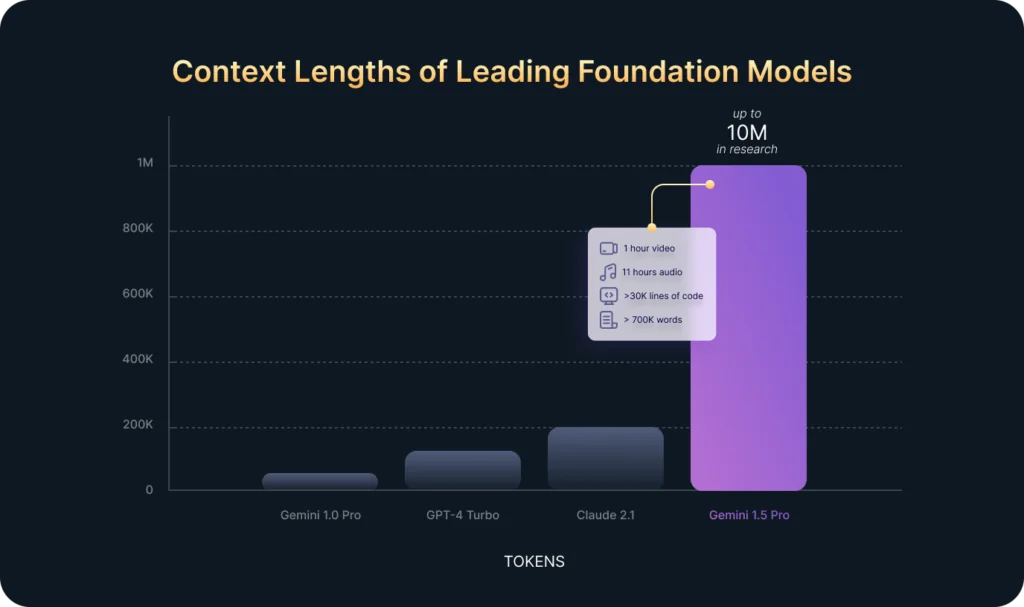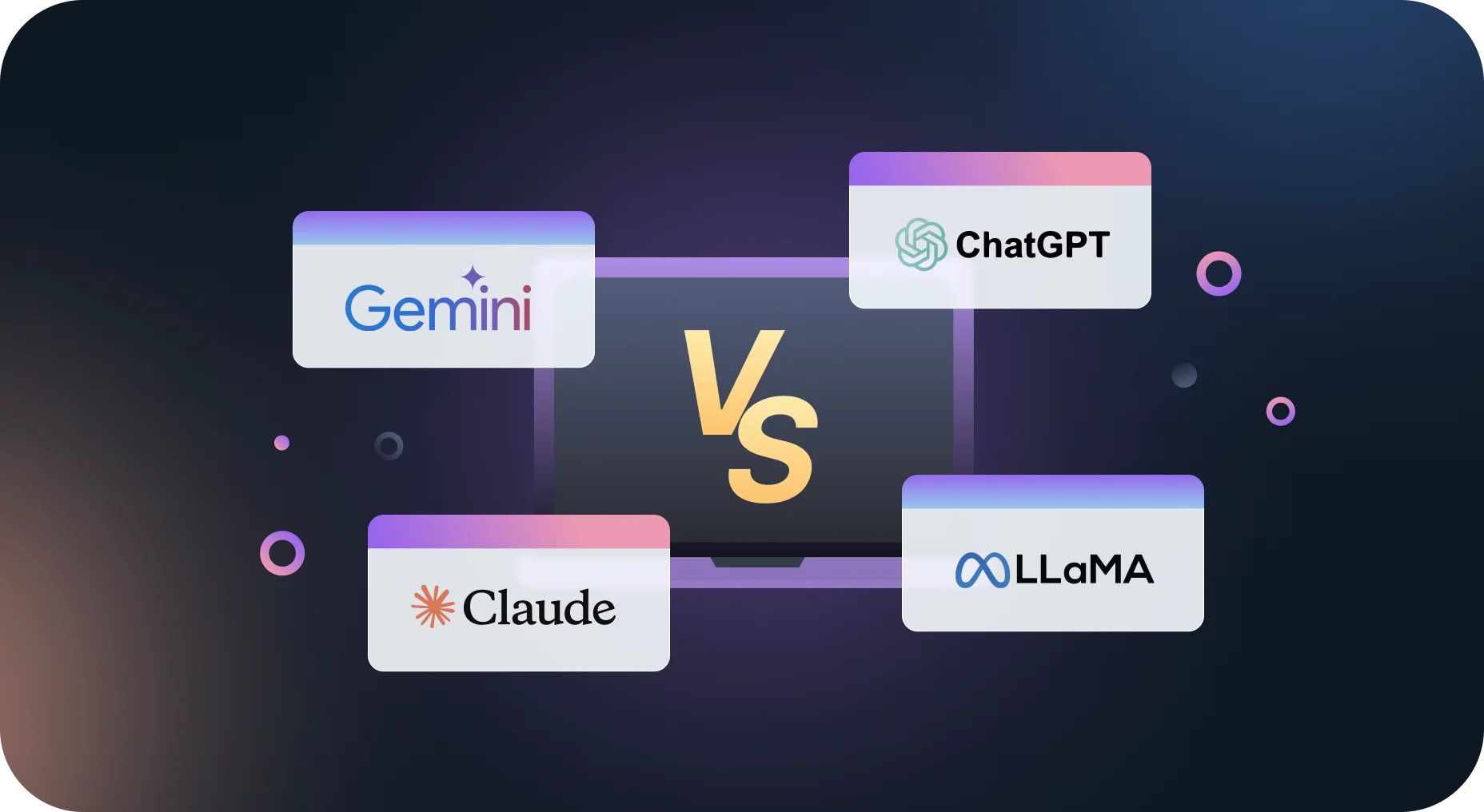Table of contents
AI is a revolutionary technology, and its rapid growth is why you need some generative AI comparison sources right now. This tech has spread and evolved so fast that it’s hard to understand exactly what the solutions available on the market are capable of. Despite having some similar functionality, generative AI tools differ quite a bit. So, read on to learn the best time to use each top AI model.
Who Needs This Generative AI Comparison Guide?
If you use the Internet today, you will benefit from reading this simple guide on AI model comparison. This technology is quickly spreading to different areas of our daily and, most of all, professional lives. Therefore, knowing which AI tool to use and when is key to staying ahead.
There are numerous areas of business where you can implement AI, so you will definitely find ways to use this technology to boost your outcomes.
Today, the market provides a variety of large language models (LLMs). Each of them has different tools and capabilities. Some are best used for coding only, while others perform exceptionally well in creative tasks. As a result, it’s pretty confusing and complicated to pick the right AI tools for your purposes. That’s why Devtorium R&D experts prepared this short guide on four of the most effective LLMs and their best use cases.
Comparison of Generative AI Tools: Benefits and Uses

ChatGPT
ChatGPT stands for “Chat Generative Pretrained Transformer.” OpenAI developed this LLM and currently offers three models: GPT-3.5, GPT-4, and GPT-4o.
- Chat GPT-3.5 is a free version that anyone can access. However, it has many limitations, like no image input or complex task processing.
- Chat GPT-4 is a $20/month subscription version designed for professional use. The model has excellent contextual understanding and creative reasoning. Among its drawbacks is slower task processing speed due to model complexity.
- Chat GPT-4o (or ChatGPT-4 Turbo) is a brand-new version of ChatGPT-4 that offers similar capabilities but is cost-efficient and speed-optimized. This tool has free and paid plans with varying limits. Also, among its inputs can be text, images, audio, and video. Even though GPT-4o has a bit worse context retention than Chat GPT-4, this model still balances exceptional outputs with processing speed.
Best ChatGPT applications:
- Cost-effective solution
For budget-conscious projects, models like ChatGPT-4o offer a balance between performance and affordability. - Hard prompts
Advanced versions like ChatGPT-4o would be effective if complex or nuanced responses are necessary. Moreover, according to the LMSYS Chatbot Arena Leaderboard, the best hard prompt performance out of 126 AI models shows ChatGPT-4o. - Longer queries
ChatGPT excels at understanding context and coherence across extended conversations, making it ideal for in-depth discussions or multi-step tasks. - Versatile applications
From creative writing to code generation, ChatGPT developed its available functions evenly.
Claude
Not a common name in most AI comparison guides, Claude is a family of AI language models developed by Anthropic. These LLMs focus on providing safe AI interactions. Claude 3 Haiku, Claude 3 Opus, and Claude 3.5 Sonnet are among the models currently available to general users.
- Claude 3 Haiku has the highest response time of all Anthropic models. It’s ideal for concise prompts and fast tasks. It’s also more affordable compared to others. However, it has limited creative capabilities and contextual understanding. It’s best suited for mobile application chatbots and instant messaging.
- Claude 3 Opus is a mid-range AI tool with moderately fast latency. It balances creativity and accuracy, offering strong contextual retention and versatility.
- Claude 3.5 Sonnet is the first release in the forthcoming Claude 3.5 model family. It’s one of the most advanced Claude models at the moment. This model is outperforming competitors in different spheres. However, it meets the same problem as Chat GPT-4: slower workflow speed due to more complex processing for richer output. Claude 3.5 Sonnet is now free on Claude.ai, while Claude Pro and Team plan subscribers can access it with significantly higher rate limits.
Best cases to use Claude:
- Code generation
Claude 3.5 Sonnet generates optimal, almost bug-free code across 20+ languages, optimizing for project-specific needs and best practices. Also, according to the LMSYS Leaderboard, Claude 3.5 Sonnet is the best coding and math task-solving AI today. - Visuals analysis
Claude 3.5 Sonnet can analyze images, documents, and PDFs, extracting essential information for diverse tasks. It’s free with basic features, but paid plans offer enhanced capabilities and higher usage limits. - Ethical AI applications
Every Anthropic’s model is built on nuanced AI principles, prioritizing safety. It also means that all responses Claude provides must adhere to them. Claude is forthright about its limitations and potential biases, promoting responsible AI use. - Complex decision-making
Claude can handle intricate scenarios with multiple variables. Moreover, it is ideal for tasks that require deep contextual awareness.
Meta LLaMA
LLaMA (Large Language Model Meta AI) is an open-source LLM developed by Meta. Its main feature is its small resource intensity, which enables researchers and developers to meet complex requests on smaller hardware. At the moment, Meta offers three models of LLaMA: LLaMA 2, LLaMA 3, and LLaMA 3.1.
- LLaMA 2 is a free-to-use OSS model of AI. It is the first openly available LLM instruction-tuned for text. It’s also great for commercial use if you struggle with huge budgets. However, this model is a bit outdated, so you can find inexpensive alternatives that provide higher performance.
- LLaMA 3 is the next generation with some significantly upgraded features. This model is multilingual and has high prompt understanding. Unfortunately, it delivers bad performance in reasoning and math.
- LLaMA 3.1 is a recent model built on LLaMA 3. It has improved reasoning and coding capabilities. Also, LLaMA 3.1 is the largest openly available model right now. So, if you want the best free-to-use AI model, this one will be a top hit according to our AI comparison.
When to use LLaMA:
- Commercial applications
This AI model is ideal for many business applications without additional costs. - Meta integration
LLaMA can be easily integrated into Meta AI, Facebook, Instagram, and WhatsApp, providing advanced AI capabilities for content generation, customer interaction, and personalized user experiences. - Multimodal tasks
The model offers robust support for diverse languages and media formats, making it a versatile tool for global and cross-platform applications.

Gemini
Gemini is an AI model developed by Google DeepMind. It is positioning itself as a competitor to advanced LLMs like GPT-4. Four Gemini models made it to our I comparison guide: Gemini Ultra, Gemini Pro, Gemini Flash, and Gemini Nano.
- Gemini 1.0 Ultra is Google’s largest model, designed for complex AI tasks. It offers maximum computational power for enterprise-level solutions and advanced AI research. This AI tool is great for advanced app integration.
- According to ratings, Gemini 1.5 Pro is the best Google AI model. It excels in general performance across a wide range of tasks. Gemini Pro can process hard prompts and follow instructions almost perfectly, making it suitable for professional-grade tools and large-scale applications.
- Gemini 1.5 Flash is a lightweight model of Gemini Pro designed for fast data analysis.
- Gemini 1.0 Nano is the most powerful on-device model available. It is ideal for mobile apps, IoT devices, and edge computing with minimal resource usage.
Top Gemini use cases:
- Overall best app
Currently, Gemini 1.5 Pro has the best results, outperforming all listed competitors. - Factual accuracy
Google’s AI relies on enormous databases and searches, ensuring its output is reliable and trustworthy. - Gmail integration
Using Gemini, you can enhance email management by providing smart reply suggestions, drafting assistance, and content generation directly within the platform.
Bottom Line: Which Model Is Best in AI Tools Comparison?
To sum it up, the current tech landscape offers a diverse range of AI solutions tailored to various business needs. From the advanced capabilities of ChatGPT and Gemini to the specialized performance of Claude and LLaMA models, each of these tools can help you.
Therefore, the best model for your specific case is the one that has the most advanced capabilities in the niche your business requires. If you want to benefit from AI integration, contact our experts for a free consultation today. We’ll help you choose a suitable AI model and develop the best implementation to enhance your business. If you want to learn more about our strengths, be sure to check our Devtorium’s case studies and verified Clutch reviews from our customers.




